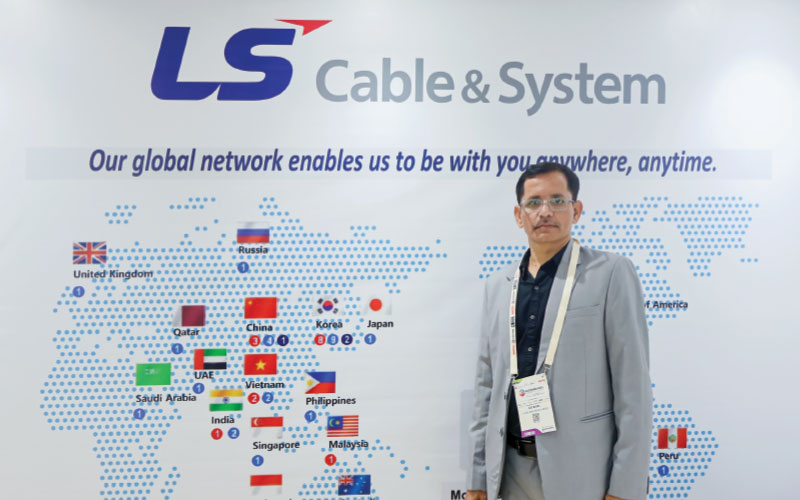LS Cable & System India has been a key player in the country’s power and telecom infrastructure, providing advanced cabling solutions for over a decade. In this exclusive conversation with Wire & Cable India, Mr. Ajay Mishra, Head of the Design Team at LS Cable & System, discusses the company’s latest offerings, expansion plans, and its role in shaping India’s evolving cable industry. He also shares insights on the growing demand for underground cabling, advancements in high-voltage & Extra high voltage power transmission, and the future of telecom networks with 5G and 6G.

Wire & Cable India: Would you like to share about LS Cable with our readers?
Ajay Mishra: LS Cable & System India (LSCI), registered as LS Cable India Pvt. Ltd., is a wholly owned subsidiary of LS Cable & System Ltd., Korea. Established in 2007, we have steadily expanded our footprint in the Indian market.
In 2012, we set up one of India’s largest power cable manufacturing plants in Bawal, Haryana, covering 162,000 square meters. This advanced facility produces EHV power cables, medium and low voltage distribution cables, OPGW for transmission line protection and communications, as well as radio RF and telecommunication cable assemblies for 4G and 5G networks.
We have played a key role in strengthening India’s power grids and communication infrastructure by supplying high-quality industrial power, specialty, and telecom cables. LS Cable offers a complete cable system solution, not just cables but also cable joints, terminations, and all related materials under one umbrella. We provide end-to-end solutions, from engineering to implementation, ensuring seamless integration and reliable performance across various industries.
Our continuous pursuit of innovation and reliability reflects our commitment to the Indian market. As we expand from telecom cables to HT cables and now up to 400 kV solutions, our goal is to establish LS Cable & System India as the leading cable manufacturer in the country.

LS Cable offers a complete cable system solution, not just cables but also cable joints, terminations, and all related materials under one umbrella.
WCI: Can you share some recent innovations happening in your company?
AM: Certainly. We have recently launched the 400 kV EHV cable, positioning us among the few manufacturers in India to offer such advanced solutions. Currently, we are conducting rigorous testing and obtaining necessary certifications to ensure these cables meet the highest standards of quality and reliability.
Besides the 400 kV cables, we are manufacturing HTLS overhead conductors. These conductors are designed to operate at higher temperatures than conventional ones, thereby enhancing the power transmission capacity of existing lines. This advancement is particularly beneficial for optimizing the efficiency of current infrastructure of Overhead Transmission lines with no extensive modifications.
Watch: Top Cable Companies in India
WCI: What are the key industry trends in the wire and cable sector?
AM: The Indian infrastructure sector is expanding rapidly, driven by urbanization and large-scale development projects. With rising land costs, there is a growing preference for underground cabling to ensure efficient electricity distribution. Two primary factors driving the shift to underground cabling are urbanization and smart city projects, which require extensive cabling solutions for power distribution.
Underground cables offer greater reliability and safety, as they are less susceptible to environmental factors like storms and accidents, reducing outages in densely populated areas. Advanced technologies, such as XLPE cables is enhancing efficiency and durability in underground networks. While the initial investment is higher, reduced maintenance costs and longer service life make underground cabling a viable long-term solution for India’s power infrastructure.
WCI: Are there any expansion plans your company is currently working on?
AM: Yes, we have land available at our company site in Rewari. We have utilized about two-thirds of it, leaving ample space for future expansion. While we are expanding gradually, we are prepared for further growth as needed.

We have recently launched the 400 kV EHV cable, positioning us among the few manufacturers in India to offer such advanced solutions.
WCI: Do you have any upcoming plans related to new products, particularly after launching OHTL conductors this year?
AM: This year, we introduced OHTL conductors and will prioritize their deployment through 2025. Our focus until 2026 is to upgrade existing overhead lines with OHTL conductors, which will significantly enhance transmission capacity.
Beyond 2026, we may consider expanding our portfolio with other types of conductors, depending on market demand and technological advancements.

We aim to remain at the forefront of the evolving telecom sector, ensuring that our products meet the future demands of both 5G expansion and the advent of 6G technology.
WCI: You mentioned the OFC and telecom market. With 6G on the horizon and 5G expanding, how do you see the telecom sector shaping?
AM: We are deeply integrated into the telecom sector and have already supplied significant materials, including heating and cables, for 5G projects.
For instance, we have partnered with Samsung for Jio’s 5G deployment. Once the BOM and BOQ are finalized for 6G, we will adjust our product line and capacity accordingly. We are also closely working with major telecom players like Vodafone Idea, Airtel, and Samsung.
Our commitment to advancing telecommunications infrastructure is evident through our strategic initiatives. In 2020, we completed our second 5G component factory in India, enhancing our capacity to supply critical components for 5G networks. This facility has enabled us to provide products to major Indian mobile carriers such as Reliance Jio, Airtel, and Vodafone, capturing about 20 percent of the Indian market.
Looking ahead to 6G, we are proactively developing next-generation technologies. It is anticipated that this technology will significantly increase data transmission capabilities, essential for the high-speed requirements of 6G networks.
By aligning our research and development efforts with industry trends and collaborating with key partners, we aim to remain at the forefront of the evolving telecom sector, ensuring that our products meet the future demands of both 5G expansion and the advent of 6G technology.
Also Read: India’s Steel Wire Sector Rewires for Scale and Specialization
WCI: Anything else you would like to add?
AM: The cable industry in India is growing at an estimated CAGR of 12 to 14 percent, and we are proud to be contributing to India’s infrastructure and economic growth. With advancements in high-voltage power transmission and next-generation telecom networks, we are continuously innovating to meet the evolving demands of the market. Our ongoing investments in R&D will further strengthen our position as a key player in India’s infrastructure with the cable and telecom sector.




